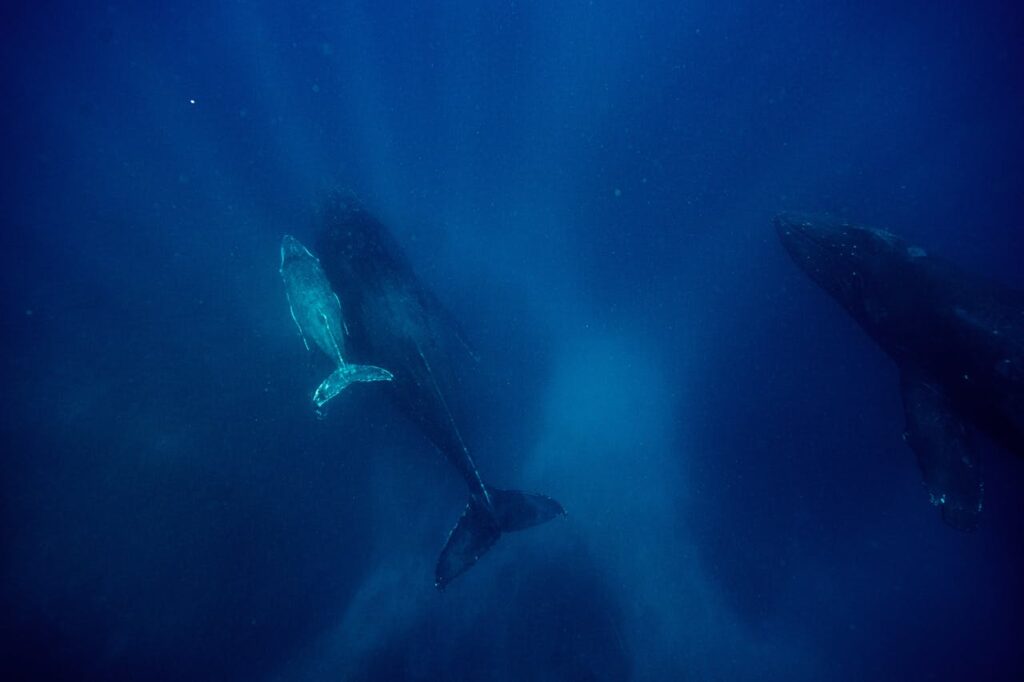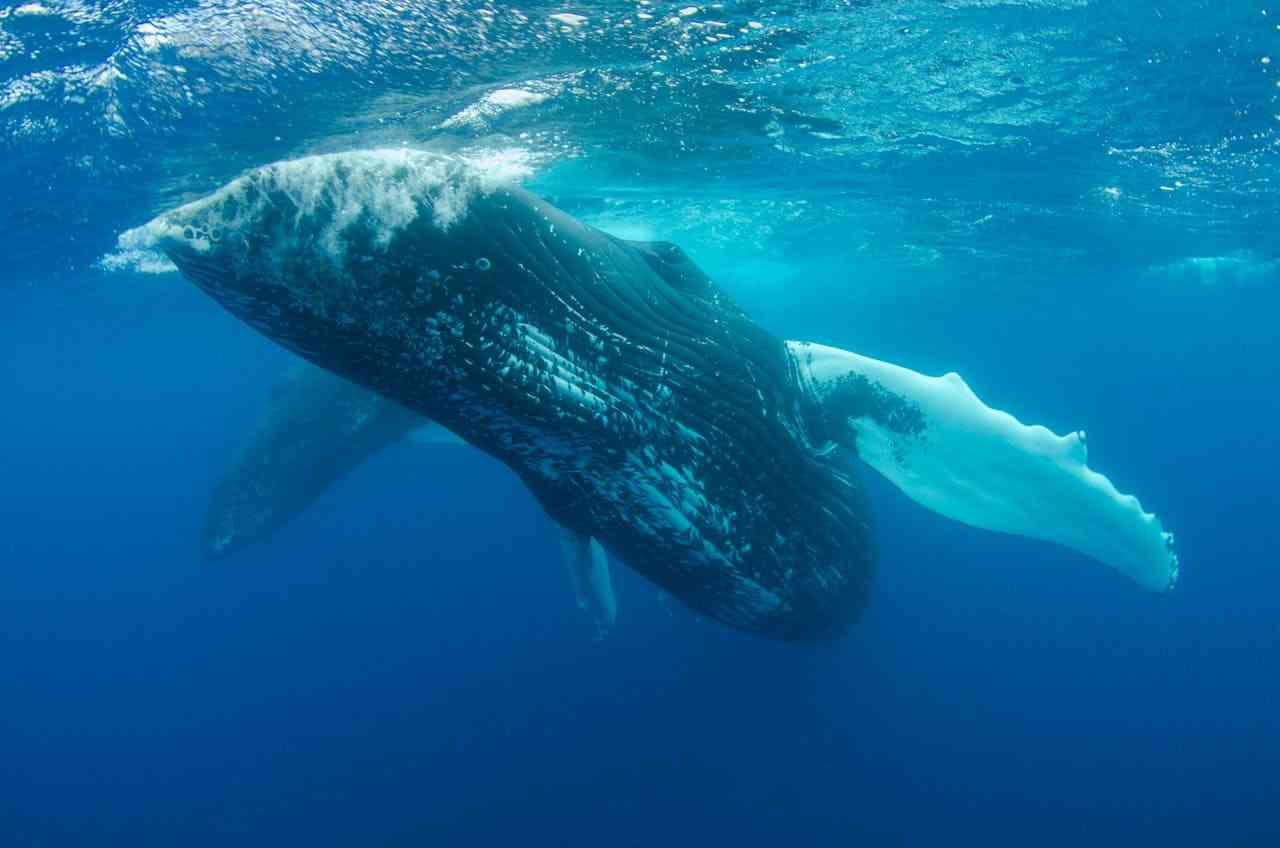Each type of whale has special features that help it live in certain places. Normally, whales only mate with their own kind or similar kinds. It was believed that blue whales mating with other whale species is not found very common.
Scientists have discovered that blue whales sometimes mate with fin whales, and their babies are called flue whales. These flue whales can even have babies with mostly blue whale traits but some fin whale traits too. This is called “backcrossing.”
When scientists looked at the DNA of North Atlantic blue whales, they found about 3.5 percent of it came from fin whales. This was surprising for even scientists because they didn’t think it would be this much. Various samples were collected from North Atlantic blue whales. Out of the six historical blue whale samples, evidence of fin whale introgression was present in four of them. There was no notable introgression with humpback whales observed in any of the sampled blue whales.
Population decline of blue whales
As per research, blue whales are in danger of disappearing. A long time ago, in the 1800s and early 1900s, people hunted and killed a lot of blue whales for their meat and blubber, which can be turned into oil. This caused the blue whale population to decrease a lot.
Blue whales are really big, and they don’t have natural enemies. The main threats to them are human-made. Even though there are laws to protect blue whales now, they still face dangers like getting caught in fishing gear, getting hit by boats, and other risks.
When whales get caught in fishing gear, they can swim for a long time with it, which makes them tired and can hurt them. This can also affect their ability to eat and have babies, and sometimes it leads to their death. Boats accidentally hitting blue whales can also hurt or kill them. This happens more often in areas with a lot of ship traffic.
Climate change is causing glaciers and frozen ground to melt quickly, and a lot of fresh water is going into the oceans. This can mess up the balance of salt in the water and the way it moves. This change can affect the blue whales because they rely on the temperature of the ocean for their migrations. It can also affect blue whales main food like krill migration patterns due to temperature changes.
Mating between two species (Introgression)
Interbreeding between blue whales (Balaenoptera musculus) and fin whales (Balaenoptera physalus) does not naturally occur in the wild. Blue whales and fin whales are distinct species with different genetic characteristics and behaviors. While they belong to the same family of baleen whales (Balaenopteridae), hence they can mate within their own species.
When parents from different but similar species mix, a new hybrid species is created. This blending, called introgression, is important because it helps make more varied genes, which is necessary for evolution. However, it’s important to know that the increase in introgression is causing difficulties for conservation efforts.
A few examples of introgression are Beefalo (Buffalo x Cow), Liger (Male Lion x Female Tiger), Wholphin (Whale x Dolphin), etc. Introgression is when genes from one species get mixed into another species over time. This happens through the repeated breeding of a hybrid (a mix of two species) with one of its parent species. It’s a slow process, even if people try to make it happen on purpose, and it can take many generations of hybrids before the genes mix significantly.
Evidence of mating between blue whales and fin whale
In 2018, a study discovered that certain whales in the rorqual group, like fin and blue whales, can have hybrid offspring due to specific genetic features. Unlike some hybrids that are unable to reproduce, these whales can because their genes are still compatible. Both fin and blue whales have 44 pairs of chromosomes and a matching chromosomal pattern revealed by a genetic test called C-banding.
In 1983, a whale caught in Iceland was identified as a mix of a fin whale mom and a blue whale dad. In 1986 and 1989, two other whales caught there were hybrids, but this time, the dad was a fin whale, and the mom was a blue whale.
The first known fertile hybrid whale was found in Icelandic waters in 1986. It was a pregnant hybrid fin/blue whale carrying a fetus fathered by a blue whale, indicating how fin whale DNA ended up in blue whales. Interestingly, the exchange of DNA between these species seems to be mostly one-sided. Blue whales have some fin whale DNA, but fin whales don’t seem to inherit blue whale DNA in the same way.
This one-sided exchange might be because blue whales are more willing to mate with hybrids, possibly because they have fewer mating options. The fin whale population is more substantial than the blue whale population, which has been struggling due to historical human hunting that brought them close to extinction in the Northern Atlantic. Despite technological advancements making it easier to hunt these whales, their population has not fully recovered.
Is introgression good or bad?

Whether mixing genes between species is good or bad depends on why it’s being done and what people want to achieve. Sometimes, it can be helpful because it increases the variety of genes, brings in useful traits, or helps organisms adapt to different environments. This mixing, called introgression, is used in farming and conservation to create crops or groups of animals that are stronger or more productive.
But, there are worries about introgression, especially when it involves moving genes between species that are very similar. This can lead to problems like spreading traits we don’t want or messing up the balance in natural areas. In some cases, introgression might be seen as not good if it harms natural populations or ecosystems.
Conclusion
We can conclude sharing genes between blue whales and fin whales is real and natural. However, experts worry that having less blue whale DNA overall might make them less able to handle changes in their environment. Luckily, when scientists studied the genes, they found that blue whales in the North Atlantic and those in the Western Atlantic exchange a lot of genes. This makes the whale population more varied and better at adapting to harsh global warming.
Read more: A new species of Ghost shark found in Thailand: Chimaera Supapae

